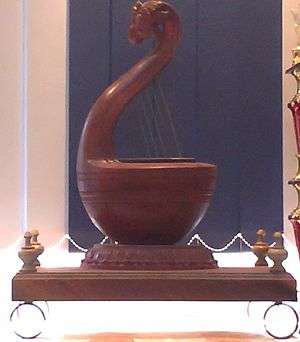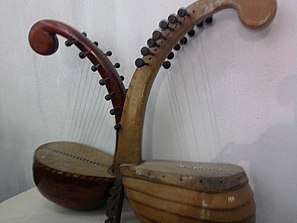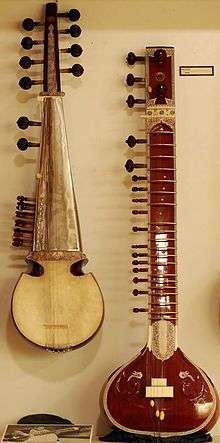Yazh
The yazh (Tamil: யாழ், also transliterated yāḻ) (pronounced "yarl") is a harp used in ancient Tamil music. A closely related word yali (யாழி முகம்) refers to any structure, particularly front, that resembles the way the tip of stem of this instrument was carved into. The yazh was an open-stringed polyphonous instrument, with gut strings (narambu) with a wooden boat-shaped skin-covered resonator and an ebony stem.[1][2]

Historical descriptions
The Tamil poet Thiruvalluvar mentions yazh in his work Thirukkural.[3] Many major Tamil classical literary masterpieces written during Sangam period have mentioned the yazh. Silappatikaram, written by a Tamil Chera prince Ilango Adigal, mentions four kinds of yazhs:[4]
- Periyazh – 21 strings
- Makarayazh – 19 strings
- Cakotayazh – 14 strings
- Cenkottiyazh – 7 strings
Yazh was played in Madurai Meenakshi Amman Temple in early centuries it was mentioned in ShaivaThirumurai 11th Pathigam. It was played by the Musician and poet Panapathirar (Tamil: பாணபத்திரர்)

- Tamil: Other types of yazh are:
மதிமலி புரிசை மாடக் கூடற் பதிமிசை நிலவு பால்நிற வரிச்சிற கன்னம் பயில்பொழில் ஆல வாயில் மன்னிய சிவன்யான் மொழிதரு மாற்றம்
பருவக் கொண்மூப் படியெனப் பாவலர்க் குரிமையின் உரிமையின் உதவி ஒளிதிகழ் குருமா மதிபுரை குலவிய குடைக்கீழ்ச் செருமா உகைக்குஞ் சேரலன் காண்க பண்பா லியாழ்பயில் பாண பத்திரன்
தன்போல் என்பால் அன்பன் தன்பால் காண்பது கருதிப் போந்தனன் மாண்பொருள் கொடுத்து வரவிடுப் பதுவே
The Tamil book Perumpāṇāṟṟuppaṭai says the strings of a yazh should not have any twists in them, and the Silappatikaram lists four types of defects in yazh.
Other Tamil literature which have mentions on yazh are Seevaga Sindhamani and Periya Puranam.[7] Yazh are seen in sculptures in the Darasuram and Thirumayam temples in Tamil Nadu and also in Amaravathi village, Guntur district.[8] Swami Vipulananda has written a book of scientific research in Tamil called the Yazh Nool.[9]
The city of Jaffna is known in Tamil as Yazhpanam. A Sri Lankan Tamil legend recounts that a blind man Panan played on the Yazh so beautiful that he was given land from a king, which he named after himself, literally meaning "town of harper".[10][11][12]
References
- "Musical instruments played in India". Chapter of SPICMACAY, Cornell University. Retrieved 16 November 2011.
- "Celebrating unheard melodies". The Hindu. India. 25 December 2010.
- Xavier S. Thani Nayagam, ed. (1966). Tamil culture. Tamil (Indic people) (in English and Tamil). 12. Tamil Literature Society, Academy of Tamil Culture. pp. 208, 209.
- Rangarajan, Haripriya (2001). Haripriya Rangarajan; G. Kamalakar; A. K. V. S. Reddy; M. Veerender; K. Venkatachalam (eds.). Jainism: art, architecture, literature & philosophy. Religion / Jainism (in English and Tamil). Sharada Publishing House. p. 142. ISBN 9788185616773.
- "Musical Instruments". Government Museum, Chennai, India. p. 2. Archived from the original on 27 September 2011. Retrieved 16 November 2011.
- "Musical Instruments". Government Museum, Chennai, India. p. 3. Archived from the original on 27 September 2011. Retrieved 16 November 2011.
- "On the basics of conservation". The Hindu. India. 4 December 2009.
- "Recreating treasures of the past". The Hindu. India. 26 December 2007.
- "One hundred Tamils of the 20th century: Swami Vipulananda (1892–1947)".
- Pārlimēntuva, Ceylon (1 January 1957). Ceylon Sessional Papers. Government Press.
- Katiresu, Subramanier (1 January 2004). A Hand Book to the Jaffna Peninsula and a Souvenir of the Opening of the Railway to the North. Asian Educational Services. ISBN 9788120618725.
- Rasanayagam, C.; Rasanayagam, Mudaliyar C. (1 January 1993). Ancient Jaffna: Being a Research into the History of Jaffna from Very Early Times to the Portuguese Period. Asian Educational Services. ISBN 9788120602106.
